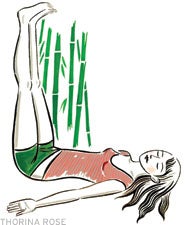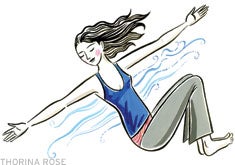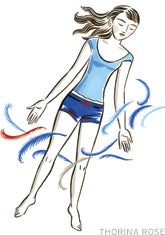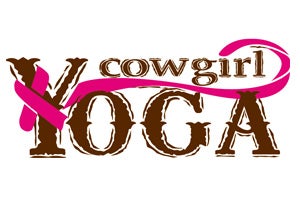Heading out the door? Read this article on the new Outside+ app available now on iOS devices for members! Download the app.
At 22, Melissa D’Angelo was lost. Her life looked enviable from the outside—she had a college degree, a loving family, a good job. But as she found herself increasingly dependent on drugs, she battled to find balance and stability.
Her addictive behaviors started gradually. In high school, D’Angelo began experimenting with drugs, often spending her weekends smoking pot and drinking. In college, partying became more than a weekend indulgence. She received a BA in psychology and took a job as a caseworker for Youth Opportunities Upheld (YOU), a residential facility for kids with behavioral problems in Worcester, Massachusetts.
Soon after, as she struggled to manage the stresses of her new job and a tumultuous relationship, she fell into smoking pot to get through the day. After a kidney operation, she had access to painkillers; she moved on to drugs like OxyContin and cocaine. Eventually she quit her job and moved in with her boyfriend, despite his infidelity and addictions. “I was too weak to leave him,” she recalls. “I thought I loved him, and on OxyContin everything was fine. Of course, then I started using all the time.”
That began a two-year struggle that included detox, rehab, and relapse. She started shooting heroin, and, after a few arrests—for possession, driving with a suspended license, and breaking and entering—a court-ordered stint at a Boston women’s rehabilitation facility helped her see she needed to make a change. “I had low self-esteem and low self-worth,” she recalls. “But something inside of me told me this wasn’t how my life was supposed to be.”
Eventually she moved into Hello House, a residential facility that offered a gentle yoga program. “I absolutely loved it,” says the 26-year-old, who has been sober for a year and a half. “It was an hour where I could relax with my thoughts. I felt empowered by it—more spiritually sound. And it gave me a grip on my life, an inner strength that allowed me to accept who I am and where I am and be OK with that.”
A Road to Recovery
According to the U.S. Department of Health and Human Services, D’Angelo is one of more than 22 million Americans who struggle with substance dependence or abuse. Drug abuse not only causes emotional and financial suffering for addicts and their families but is a costly public health problem, one that the National Institute on Drug Abuse estimates at more than $484 billion a year. With relapse rates higher than 40 percent, addiction specialists as well as those in recovery are turning to adjunct therapies such as yoga as a way to supplement traditional 12-step programs.
These days it’s difficult to find any private rehabilitation facility that doesn’t offer some form of yoga or mind-body awareness programming. Some teach meditation, so that recovering addicts can learn to sit quietly and calm the body and mind with the breath, and experience feelings of peace and comfort. Other facilities teach a series of postures that are simple enough for people who have never done yoga and who probably have not taken good care of their bodies. The goal is to give addicts the skills they need to learn in order to tolerate the uncomfortable feelings and sensations that can lead to relapses. (An example of this kind of yoga practice is featured on page 2 of this article.)
“When people take substances, they’re seeking a certain experience, whether it’s escapist or transcendental or just wanting a different psychological state, to get away from whatever is making them unhappy,” explains Sat Bir Khalsa, director of the Kundalini Research Institute and an assistant professor at Harvard Medical School. Khalsa wrote a study on a small pilot program in India that featured yoga as the main intervention in its substance-abuse treatment. “Yoga is an alternative, a positive way to generate a change in consciousness that, instead of providing an escape, empowers people with the ability to access a peaceful, restorative inner state that integrates mind, body, and spirit.”
Back to the Body
The importance of developing a positive relationship with physical sensation is one reason that the Betty Ford Center in Rancho Mirage, California, has offered yoga as part of its fitness regime for more than 10 years. “Addiction takes a person out of their body and prevents them from connecting to who they are physically and feeling what their body is telling them,” says Jennifer Dewey, Betty Ford’s fitness manager. “Yoga is a great way to slowly reintroduce someone to physical sensation. It’s also very relaxing, so in terms of the anxiety, stress, and depression that arise from detox, it’s invaluable in helping people stay calm and grounded.”
In fact, the 1930s tome, The Big Book, written by the founders of Alcoholics Anonymous to explain the 12 steps of recovery, also emphasizes that the physical body is as important as the emotions: “But we are sure that our bodies were sickened as well,” it says. “In our belief, any picture of the alcoholic which leaves out this physical factor is incomplete.”
This whole-body approach to recovery is something that resonates with former addicts like Vytas Baskauskas, who teaches Power Yoga in Santa Monica, California. While he attributes his sobriety to the 12-step program and the camaraderie it provides, he admits that it isn’t always successful in providing tools to address bodily discomforts and issues. “A lot of people come to AA to get sober, and yet they’re still riddled with physical maladies and imbalances,” he observes.
Baskauskas, who has been sober for 10 years, experienced such maladies firsthand. The 12-step program introduced him to a spiritual way of life, but it didn’t offer a way to relieve the back pain that had plagued him for almost five years after quitting heroin. He came to yoga a skeptic, but once he got on the mat, he says, the pain dissipated and his perspective changed rapidly. “Yoga was challenging, and it opened my mind and my body. It enlivened places that had been dead for so long, and as I worked my body, I found a refuge, some relief from feeling like a prisoner of my own thoughts.”
Yoga also complemented the spiritual path that he had begun in AA. “When you’re an addict,” Baskauskas says, “you often have a hole in your life, and by filling it with the philosophy of yoga, God—whatever you want to call it—that’s a high too. But it’s a high that won’t kill your relationships, hurt your family, or your body.”
Up and Walking
The use of yoga to treat addiction has even crept into the pop-culture landscape. Perhaps one of the more poignant moments of VHI’s reality hit Celebrity Rehab with Dr. Drew [Pinsky] was with Taxi and Grease star Jeff Conaway, who by then was using a wheelchair. Addled with pain and hooked on painkillers and alcohol, Conaway does simple yoga poses and is then able to get out of his chair and walk. Pinsky, an addiction specialist who has also hosted the syndicated radio advice show Loveline for two decades, says yoga offers more than just physical relief. “Because of the biological changes in addicts’ brains, motivational priorities are distorted,” says Pinsky. “Attuning to bodily based cues through active modalities such as yoga can go a long way to helping patients begin to be more mindful in their responses.”
Yet in spite of such media attention and anecdotal evidence from people such as Baskauskas and D’Angelo, there hasn’t been a lot of medical research into the benefits of yoga for recovering addicts.
“No one is really focused on it from a scientific perspective,” says physician David Simon, the medical director at the Chopra Center for WellBeing and coauthor of Freedom From Addiction. “But that doesn’t mean it’s not valuable.”
Simon says that people often engage in addictive behavior to regulate their moods. “If you don’t know how to modulate your own anxiety, depression, or fatigue through healthy means, then you’ll turn to things like sedatives, pain relievers, amphetamines, and alcohol.”
The Science Behind Addiction
As we learn more about how yoga affects us physiologically, researchers like Khalsa say, we get clues as to why it can be helpful to those in recovery. “Yoga is very effective at regulating the stress hormones cortisol and adrenaline,” Khalsa says. In fact, he points out that an imbalance of those hormones has been associated with anxiety disorders, depression, and posttraumatic stress disorder as well as substance abuse. “These chronically high levels of hormones are toxic to the body and central nervous system, and we know yoga can help reduce or balance the stress hormones in the body. It makes sense that if you’re less stressed, you may not be so quick to seek substances to cope.”
D’Angelo says this calming effect is something she taps into often. When she gets anxious, there’s nothing better than doing Adho Mukha Svanasana. “At work, if I’m stressed, I’ll literally go into the bathroom and do Downward Dog,” she says. “It puts me in a relaxed state and allows me to clearly focus on what I need to be doing—not [on] what I want to be doing, which may be relapsing.”
A small 2007 pilot study published in the Journal of Alternative and Complementary Medicine, funded in part by a grant from the National Institute on Drug Abuse, demonstrated that yoga may be able to change brain chemistry. The study compared a session of reading to a session of yoga and concluded that the yoga session resulted in increased levels of the neurotransmitter GABA in the brain, while the readers experienced no change. Low levels of GABA are associated with anxiety and depression, conditions often considered to underlie addiction.
For people in recovery like D’Angelo, managing those conditions is the key to preventing a relapse. “Practicing yoga is the right decision for my recovery,” she says. “It makes me feel good about myself, and since so much of my addiction had to do with feeling ‘less than,’ it gives me the extra strength I need to be self-reliant, get to meetings, and stay sober.”
Once someone gets sober, the next step is staying sober. G. Alan Marlatt has spent a lot of his career looking at relapses among those in recovery. As the director of the Addictive Behaviors Research Center at the University of Washington, he has been studying the benefits of meditation in treating addiction for 30 years. A longtime meditator himself, Marlatt has published studies demonstrating that vipassana meditation (or mindfulness) can be effective at helping addicts to curtail substance abuse—especially those for whom the traditional 12-step program does not resonate.
“The 12-step program takes the approach that addiction is a disease that cannot be cured and that cravings need to be pushed away or averted,” Marlatt says. “If you have cravings or urges, there are two strategies. You avoid or suppress them, taking a nonaccepting approach. Or you can pay attention to the physical sensation, pay attention to how the cravings and urges manifest themselves, identify them, accept them, and then let them go. You can just let it pass and notice the impermanence.”
Marlatt describes the latter as “radical acceptance”—the idea that one can acknowledge a craving for substances but not act on that urge. In a 2006 study published in Psychology of Addictive Behaviors, Marlatt put this theory to the test when he compared the effectiveness of vipassana meditation, as taught by the Buddhist teacher S. N. Goenka, with that of traditional 12-step treatment protocols and other treatment strategies among a group of inmates in a Seattle prison who were all struggling with addiction issues. In a three-month follow-up after their release from prison, those who had taken the meditation course showed significantly less alcohol and drug use than the control group. For example, those who had taken the vipassana course reported having 8 drinks per week, while those who had gone through traditional treatment said they had more than 27 drinks a week. Those using crack cocaine who had not taken the meditation course used the drug about 1 in every 5 days after they were released from prison, while those who did take the meditation course used it only 1 in every 10 days.
Harm-Reduction Approach
Sarah Bowen, coauthor of the study with Marlatt and a researcher at the University of Washington, says this Buddhist-based approach posits that any reduction in harm is a good thing: “Not everyone is ready or able to quit altogether, and we don’t want that to be a barrier to treatment. We take the harm-reduction approach, where we meet people wherever they are, and as they reduce their use or begin to use in safer ways, they have fewer negative consequences in many aspects of their lives.”
Marlatt has secured funding from the National Institute on Drug Abuse for a program he’s calling Mindfulness-Based Relapse Prevention, in which yoga is part of the protocol. While he won’t publish data for at least a year, he does say researchers have already found that yoga helps people accept the negative emotions and physical cravings that so often lead to a relapse.
Of course, addiction affects more people than just the addict. Those who live with and love an addict can also -benefit from yoga. Annalisa Cunningham returned to her yoga practice after her marriage to an alcoholic disintegrated. She was nervous and tense. Her neck and shoulders always hurt, and she developed insomnia. Although she wasn’t an addict herself, she had grown up in an alcoholic family. She found her way into a 12-step meeting designed for family members and spouses of addicts, and began to heal. The 12-step philosophy and her yoga practice helped her surrender the desire to control her circumstances and gave her quiet time each day to reflect on her own spirituality while building physical strength, endurance, and solace. “It enabled me to care for myself in a new way,” she says.
Cunningham went on to get a master’s degree in counseling and started working with addicts, designing yoga classes that brought 12-step philosophies onto the mat. She created classes around concepts like self-forgiveness and self-acceptance, introducing journal-writing exercises and offering Pranayama and meditation techniques. In 1992 she combined what she knew about yoga with what she knew about recovery and wrote Healing Addiction With Yoga. All this, she says, changed her perspective toward yoga as well. “My practice and my teaching began to take on a greater purpose,” she says. “I’m more interested in finding inner peace than I am in practicing the perfect posture.”
D’Angelo also views her yoga practice as a respite; in fact, she too hopes to teach yoga some day. But right now her focus is on staying sober, and that means working her 12-step program into her hectic workdays in catering as she gets her life back on track. “For me, yoga is not a requirement for sobriety. It’s not something I have to do; it’s something I choose to do.” And she takes great solace in doing something just for herself. “Yoga is definitely a tool that keeps me on the right path. As soon as I get on the mat, I am able to tap into something inside me that nothing else can touch. Not therapy, not the steps. It allows me to be me.”
Stacie Stukin lives in Los Angeles and blogs for Yoga Journal.
As you practice the following sequence, remember to honor your limitations, going to your edge with love and acceptance rather than judgment and discouragement. If you are unable to move into a posture at this time, focus on breathing deeply as you think about the affirmation—that in itself is healing. At the end of the routine, take some time to write down your thoughts.
1. Vajrasana (Sitting Mountain), variation

Benefits: Opens the heart and invites stillness into the body.
Affirmation: Serenity comes when I surrender.
Kneel on the floor, with your knees pointed forward and your feet stretched behind you. Now sit back on your heels so that your back is upright. You can put a pillow under your buttocks or knees for padding in order to be comfortable in the position; if you cannot kneel, sit on a chair so that your spine remains straight rather than hunched over. Relax your shoulders. Keep your chest open. Breathe deeply and slowly to help you relax the body and mind. Imagine that you are firmly planted like a mountain, energy going up your spine, feeling strong and serene.
2. Balasana (Child’s Pose)

Benefits: Releases tension in the shoulders and spine and relieves mental fatigue. Encourages feelings of safety and protection, as though you were in a womb of healing energy.
Affirmation: I rest in trust and patience.
Begin in Sitting Mountain Pose, sitting on your feet with your toes touching and your heels separated. Inhale.
As you exhale, gently lower your head to the floor in front of your knees. Place your hands, palms up, next to your feet. Completely relax the neck and shoulders. Hold this position while breathing for 5 minutes or as long as you are comfortable. Use pillows or bolsters for support under your torso or forehead if you have a tight lower back or stiff hips, knees, or ankles.
3. Paschimottanasana (Seated Forward Bend)

Benefits: Helps stretch the hamstrings and lower back. It also fosters a sense of calm and letting go, while gently stretching the spine.
Affirmation: I move forward with patience.
Sit on the floor with your legs extended in front of you. Sit up straight and rotate your ankles, flexing and stretching them. Keeping your feet flexed, inhale and lift your arms above your head. As you exhale, bend at the hips and lower your chest toward your knees. Keep your spine straight as you do this. Place your hands on your calves, ankles, or feet, wherever you can comfortably reach. Hold the pose for 10 breaths.
4. Baddha Konasana (Butterfly)

Benefits: Gently opens the pelvis and hips.
Affirmation: My spirit is as gentle as a butterfly.
Sit up straight. Bring the bottoms of your feet together, pulling them in toward your groin. Your knees should be out to the sides so your legs are like a butterfly’s wings. Inhale. As you exhale, lean forward. Clasp your feet and begin pressing your forearms into your upper thighs, gently inviting your legs toward the floor. Breathe.
You can also lie back in the supine variation. Bring your arms out to the sides, and relax as you breathe deeply.
5. Viparita Karani (Legs-up-the-Wall Pose)

Benefits: Relaxes the legs and feet by relieving pressure.
Affirmation: As I relax, I gain insight, clarity, and ease.
Sit on the floor next to a wall, with your knees bent and your left hip and side barely touching the wall. Using your hands for support, slowly lie back and swivel your hips so that you can slide both legs up the wall and your buttocks press against it. You can let your arms relax either at your sides or on your belly.
Straighten your legs. (If you have tight hamstrings, bend your knees or move your buttocks farther away from the wall.) Hold the pose and breathe. You can place a pillow under your head or lower back for more support.
6. Apanasana (Little Boat Hugging Knees)

Benefits: Releases the lower back and lengthens the spine.
Affirmation: I hold myself with compassion.
Lie on your back and bring your knees in toward your chest. Wrap your arms around your knees and legs, hugging them toward you. Keep your chin slightly tucked so your neck stays long on the floor.
Hold the position and breathe.
7. Jathara Parivartanasana (Knee-Hug Spinal Twist)

Benefits: Releases the lower back and lengthens the spine. Increases flexibility of the spine, back, and ribs.
Affirmation: Everywhere I turn I see beauty.
Lie on your back and hug your knees into your chest. Keep your knees bent into your chest and place your arms out to your sides. Your palms can be up or down, whichever feels most comfortable to you. Inhale. As you exhale, move your hips and knees to the left as you turn your head to the right. Hold the position and breathe. When you are ready, do a gentle spinal twist to the other side.
8. Savasana (Corpse Pose)

Benefits: This basic pose of relaxation is done at the end of each hatha yoga session. It helps relieve the body of tension. It relaxes, rejuvenates, and replenishes the mind and body.
Affirmation: I allow myself to relax completely and surrender to my Higher Power.
Lie on your back and gently close your eyes. Place your feet and legs slightly apart.
Place your arms along the sides of your body with your palms facing up. Make sure your teeth are slightly parted so that your jaw is relaxed. Start taking some deep breaths. Lie absolutely still. Close your eyes, take deep breaths, and let healing energy restore any areas of the body or mind that have been depleted by stress or tension. Visualize healing energy flowing through your entire body. Relax your body, quiet your mind, and soothe your soul. Stay in this position for up to 20 minutes.
Annalisa Cunningham is the author of Healing Addiction With Yoga.